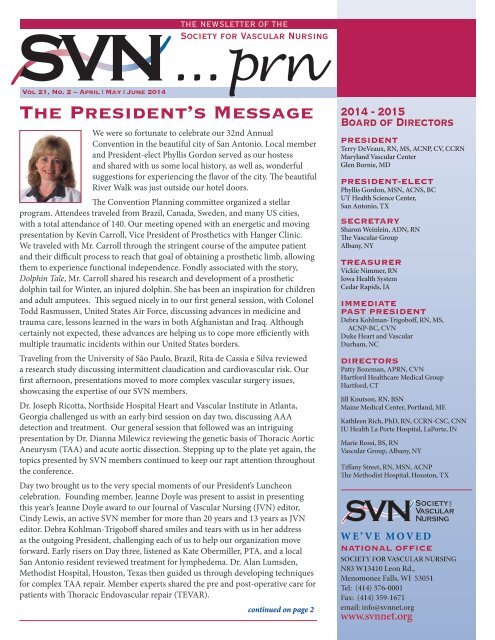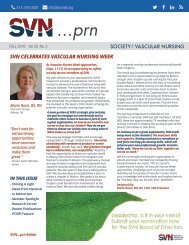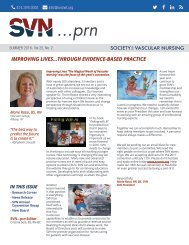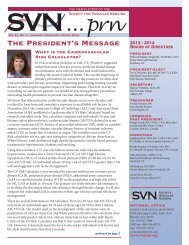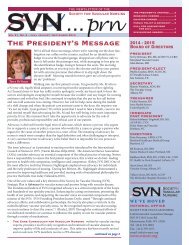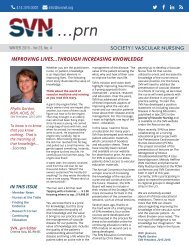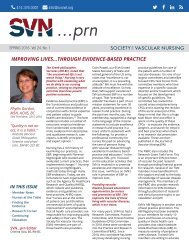SVN...prn Spring 2014
Create successful ePaper yourself
Turn your PDF publications into a flip-book with our unique Google optimized e-Paper software.
Vol 21, No. 2 – April | May | June <strong>2014</strong><br />
The President’s Message<br />
We were so fortunate to celebrate our 32nd Annual<br />
Convention in the beautiful city of San Antonio. Local member<br />
and President-elect Phyllis Gordon served as our hostess<br />
and shared with us some local history, as well as, wonderful<br />
suggestions for experiencing the flavor of the city. The beautiful<br />
River Walk was just outside our hotel doors.<br />
The Convention Planning committee organized a stellar<br />
program. Attendees traveled from Brazil, Canada, Sweden, and many US cities,<br />
with a total attendance of 140. Our meeting opened with an energetic and moving<br />
presentation by Kevin Carroll, Vice President of Prosthetics with Hanger Clinic.<br />
We traveled with Mr. Carroll through the stringent course of the amputee patient<br />
and their difficult process to reach that goal of obtaining a prosthetic limb, allowing<br />
them to experience functional independence. Fondly associated with the story,<br />
Dolphin Tale, Mr. Carroll shared his research and development of a prosthetic<br />
dolphin tail for Winter, an injured dolphin. She has been an inspiration for children<br />
and adult amputees. This segued nicely in to our first general session, with Colonel<br />
Todd Rasmussen, United States Air Force, discussing advances in medicine and<br />
trauma care, lessons learned in the wars in both Afghanistan and Iraq. Although<br />
certainly not expected, these advances are helping us to cope more efficiently with<br />
multiple traumatic incidents within our United States borders.<br />
Traveling from the University of São Paulo, Brazil, Rita de Cassia e Silva reviewed<br />
a research study discussing intermittent claudication and cardiovascular risk. Our<br />
first afternoon, presentations moved to more complex vascular surgery issues,<br />
showcasing the expertise of our <strong>SVN</strong> members.<br />
Dr. Joseph Ricotta, Northside Hospital Heart and Vascular Institute in Atlanta,<br />
Georgia challenged us with an early bird session on day two, discussing AAA<br />
detection and treatment. Our general session that followed was an intriguing<br />
presentation by Dr. Dianna Milewicz reviewing the genetic basis of Thoracic Aortic<br />
Aneurysm (TAA) and acute aortic dissection. Stepping up to the plate yet again, the<br />
topics presented by <strong>SVN</strong> members continued to keep our rapt attention throughout<br />
the conference.<br />
Day two brought us to the very special moments of our President’s Luncheon<br />
celebration. Founding member, Jeanne Doyle was present to assist in presenting<br />
this year’s Jeanne Doyle award to our Journal of Vascular Nursing (JVN) editor,<br />
Cindy Lewis, an active <strong>SVN</strong> member for more than 20 years and 13 years as JVN<br />
editor. Debra Kohlman-Trigoboff shared smiles and tears with us in her address<br />
as the outgoing President, challenging each of us to help our organization move<br />
forward. Early risers on Day three, listened as Kate Obermiller, PTA, and a local<br />
San Antonio resident reviewed treatment for lymphedema. Dr. Alan Lumsden,<br />
Methodist Hospital, Houston, Texas then guided us through developing techniques<br />
for complex TAA repair. Member experts shared the pre and post-operative care for<br />
patients with Thoracic Endovascular repair (TEVAR).<br />
continued on page 2<br />
<strong>2014</strong> - 2015<br />
Board of Directors<br />
PRESIDENT<br />
Terry DeVeaux, RN, MS, ACNP, CV, CCRN<br />
Maryland Vascular Center<br />
Glen Burnie, MD<br />
PRESIDENT-ELECT<br />
Phyllis Gordon, MSN, ACNS, BC<br />
UT Health Science Center,<br />
San Antonio, TX<br />
SECRETARY<br />
Sharon Weinlein, ADN, RN<br />
The Vascular Group<br />
Albany, NY<br />
TREASURER<br />
Vickie Nimmer, RN<br />
Iowa Health System<br />
Cedar Rapids, IA<br />
IMMEDIATE<br />
PAST PRESIDENT<br />
Debra Kohlman-Trigoboff, RN, MS,<br />
ACNP-BC, CVN<br />
Duke Heart and Vascular<br />
Durham, NC<br />
DIRECTORS<br />
Patty Bozeman, APRN, CVN<br />
Hartford Healthcare Medical Group<br />
Hartford, CT<br />
Jill Knutson, RN, BSN<br />
Maine Medical Center, Portland, ME<br />
Kathleen Rich, PhD, RN, CCRN-CSC, CNN<br />
IU Health La Porte Hospital, LaPorte, IN<br />
Marie Rossi, BS, RN<br />
Vascular Group, Albany, NY<br />
Tiffany Street, RN, MSN, ACNP<br />
The Methodist Hospital, Houston, TX<br />
WE’VE MOVED<br />
NATIONAL OFFICE<br />
SOCIETY FOR VASCULAR NURSING<br />
N83 W13410 Leon Rd.,<br />
Menomonee Falls, WI 53051<br />
Tel: (414) 376-0001<br />
Fax: (414) 359-1671<br />
email: info@svnnet.org<br />
www.svnnet.org
continued from page 1... Pres. Message<br />
Our closing session, also provided by Hanger Clinic was<br />
amazing. Katy Sullivan, actress and amputee, shared with<br />
us her inspirational story of growing up without her legs.<br />
Smiles and laughter filled the room as she shared hope and<br />
optimism, not sadness. As a parent, I could not help but<br />
think of the challenges that her mother had faced and yet<br />
as Katy explained, her Mom let her stumble and find her<br />
way, giving her confidence and independence.<br />
We cannot dismiss the importance of the social part of our<br />
meeting, seeing old friends, reminiscing about the way<br />
it was, making new friends, meeting new members and<br />
sadly sometimes seeing colleagues off to new adventures.<br />
Even in these sessions, the knowledge shared was evident.<br />
We have an amazing organization and through shared<br />
expertise the <strong>SVN</strong> has developed wonderful educational<br />
materials for patients and nurses available through the<br />
The President’s Updates…<br />
March <strong>2014</strong><br />
The Board reviewed and is focusing on these major themes from<br />
the member satisfaction survey:<br />
• Request for more CEU opportunities. <strong>SVN</strong> is exploring the cost<br />
of increased on-line or webinar opportunities.<br />
• Local interaction for members; explore the idea of regional<br />
meetings, virtual chapters.<br />
• Members are looking for more basic vascular education.<br />
<strong>SVN</strong> is working on tool kits which will be a great resource.<br />
• <strong>SVN</strong> is promoting membership to Magnet hospitals, reaching<br />
out to 13 states without <strong>SVN</strong> members.<br />
• Scope and Standards draft was sent out to members for review.<br />
After final review by the Task Force the document will be sent<br />
to ANA for publication.<br />
• A new PAD position statement has been added to the <strong>SVN</strong><br />
website home page.<br />
April <strong>2014</strong><br />
• San Antonio convention program distributed to collaborating<br />
organizations. Convention Planning Committee finalizing details<br />
for the San Antonio meeting, with great excitement for our Keynote<br />
and Invited speaker presentations.<br />
• Collaboration continued with Vascular Endovascular and Surgical<br />
Society (VESS) formerly PVSS, with a plan for joint participation<br />
in future meetings of each society.<br />
• ANCC Cardiac and Vascular Certification materials will be<br />
available at the conference registration desk.<br />
www.svnnet.org<br />
<strong>SVN</strong> website. Congratulations to all of our talented award<br />
winners this year. We continue active collaboration with our<br />
physician colleagues and are spreading our wings with plans<br />
in progress for international collaborations in South Africa<br />
and India.<br />
As Debra shared in her address, we need each of our members<br />
to consider just one of many ways to be an active participant<br />
in <strong>SVN</strong>. We need your help to move forward and to grow<br />
our member numbers. I challenge you to think of Katy’s<br />
mother and her success in stepping out of her comfort zone,<br />
allowing her child to try and to succeed so amazingly. Let us<br />
try coloring outside of the lines, approaching change with<br />
creativity, not regimented ideas. We are challenged with the<br />
economy, health care changes, and our individual concerns,<br />
but together we can raise the bar, providing excellence, respect<br />
and advocacy for vascular nurses and persons living with<br />
vascular disease.<br />
• Public Policy and Advocacy sending<br />
out requests to state governors for the<br />
proclamation of Vascular Nurses Week,<br />
the second week in June.<br />
• <strong>SVN</strong> very excited to receive a request for new<br />
collaboration with the Intersocietal Accreditation Commission<br />
(IAC). They have requested an <strong>SVN</strong> member for the Board of the<br />
newly launched Accreditation of Vein Centers.<br />
• <strong>SVN</strong> has also received a request to assist with development<br />
of a Vascular Nursing Society in India.<br />
May <strong>2014</strong><br />
• San Antonio Convention a wonderful success.<br />
• Your <strong>2014</strong>-15 Board welcomes President-elect, Phyllis Gordon<br />
and Director, Tiffany Street.<br />
• Congratulations to all of our award winners. Welcome our three<br />
new Chapters. Please share your comments to them on our<br />
Facebook page and Twitter.<br />
• The On-line courses via Course Park approved for reaccreditation<br />
through May of 2016.<br />
• <strong>SVN</strong> Board excited to explore new opportunities, poised to<br />
share international collaboration and continue to advocate for<br />
our members.<br />
• We welcome new Association Acumen Management and<br />
Association Manager, Leah Grunewald.<br />
• Please stay tuned to the Website for new and exciting updates.<br />
2
The Society for Vascular Nursing<br />
April | May | June <strong>2014</strong><br />
PUBLIC POLICY & ADVOCACY<br />
Screening for Peripheral Artery Disease:<br />
Legs For Life<br />
Peripheral artery disease (PAD) affects an estimated 10<br />
million people in the United States aged 40 years and<br />
older (Lin, Olson, Johnson, & Whitlock, 2013; Molher,<br />
2012). Lin et al. (2013) discuss the the underdiagnosis<br />
and undertreatment of PAD. This gap in care is in part,<br />
because most patients either do not have symptoms or have<br />
atypical symptoms. To decrease morbidity and mortality<br />
related to PAD, an increase in awareness will contribute<br />
to prevention and early treatment; screening for PAD is a<br />
critical component for timely management. Screening for<br />
PAD involves a non-invasive procedure which compares the<br />
blood pressure at the ankle with the blood pressure in the<br />
arm and a ratio is obtained- the Ankle-Brachial Index (ABI).<br />
According to the American and International guidelines,<br />
persons 50 years of age or older with a history of diabetes<br />
mellitus or smoking should have an ankle-brachial index<br />
(ABI) to evaluate for PAD ( Lin et al.; Mohler; Vascular<br />
Disease Foundation, <strong>2014</strong>). The guidelines are the same for<br />
women and men. PAD is found to be more prevalent in men<br />
than women (Lin et al.; Molher). Treatment of PAD involves<br />
treating the risk factors and improving mobility.<br />
The risk factors for developing PAD align with the risk<br />
factors for heart attack and stroke, namely smoking,<br />
diabetes, hypertension, hypercholesterolemia, obesity and<br />
decreased physical activity (Lin et al.; Molher; Vascular<br />
Disease Foundation). The classic symptom of PAD is<br />
claudication which is discomfort in the affected leg with<br />
activity which resolves almost immediately with rest. The<br />
severity of PAD is dependent on how extensive the disease<br />
is, as well as any pre-existing health factors (Molher,<br />
Vascular Disease Foundation). With critical limb ischemia<br />
(CLI), rest pain is present; revascularization is attempted for<br />
limb salvage and if unsuccessful or if there are no treatment<br />
options, then amputation may be required (Vascular Disease<br />
Foundation).<br />
The Society of Interventional Radiology (SIR) founded a<br />
program, Legs for Life, in 1997 dedicated to improving the<br />
cardiovascular health of the community. “Legs for Life is a<br />
public education/community wellness program that screens<br />
people who may be at risk for PAD and helps them take<br />
the next step in resolving the pain they are experiencing”<br />
(Society of International Radiology, 2013). The mission<br />
of the program is to improve the cardiovascular health<br />
3<br />
of people in our communities. The primary goals of the<br />
program are to “educate primary care physicians and the<br />
medical community to identify patients at risk and to<br />
strengthen collaborative relationships among health care<br />
providers” (Society of International Radiology).<br />
The SIR has declared September as Legs For Life National<br />
Screening Month for PAD Leg Pain. The Society of<br />
International Radiology is one of several professional groups<br />
lobbying for screening for PAD.<br />
Sherida Ingram RN MScN(c)<br />
CNS Vascular Surgery<br />
<strong>SVN</strong> Public Policy & Advocacy Committee Member<br />
References<br />
Lin, J. S., Olson, C. M., Johnson, E. S., & Whitlock, E. P. (2013). The<br />
Ankle-Brachial Index for Peripheral Artery Disease Screening and<br />
Cardiovascular Disease Prediction Among Asymptomatic Adults:<br />
A Systematic Evidence Review for the U.S. Preventative Services<br />
Task Force. Annals of Internal Medicine (159), 333-341.<br />
Mohler, E. R. (2012). Screening for Peripheral Artery Disease.<br />
Circulation, (126), 111-112.<br />
Society of International Radiology (2013). Legs for Life. National<br />
Screening For Vascular Disease. Retrieved from www.legsforlife.org<br />
U.S. Preventive Services Task Force (2013). Screening for<br />
Peripheral Artery Disease and Cardiovascular Disease Risk<br />
Assessment with Ankle Brachial Index in Adults. Task Force<br />
Final Recommendation, September 2013. Retrieved from<br />
uspreventiveservicestaskforce.org<br />
Vascular Disease Foundation (<strong>2014</strong>). PAD Coalition. Peripheral<br />
Artery Disease. Retrieved from www.vasculardisease.org<br />
Do you “Like” the <strong>SVN</strong>?<br />
Are you a “Fan”?<br />
We are hoping to increase our Social Medial visibility and need your help.<br />
As more people “Like” us on Facebook, our web presence will increase and<br />
<strong>SVN</strong> will be ranked the #1 resource for Vascular Nursing.<br />
Please go to the <strong>SVN</strong> home page and click on the Facebook Icon. We have a<br />
NEW Facebook Page. If you are currently a fan of the old page please become a fan<br />
of the new page. (Due to cyberspace issues beyond our control the old page will be<br />
deactivated soon)
RESEARCH CORNER<br />
Conflicting Research Findings:<br />
What Should One Believe?<br />
www.svnnet.org<br />
Oxygen was considered in 2004 to be one of the baseline<br />
therapies recommended by the American Heart Association<br />
guideline in the care of the patient experiencing ST-segment<br />
elevation myocardial infarction (STEMI). During acute coronary<br />
occlusion, myocardial perfusion is absent; therefore it is not<br />
oxygenated. Theoretically, delivering supplemental oxygen<br />
(O2) via the blood will increase oxygenation to the endangered<br />
myocardium until a more definitive reperfusion therapy (such<br />
as a percutaneous coronary intervention or fibrinolysis) is<br />
available. This is a standard practice by pre-hospital providers and<br />
Emergency Departments. Interestingly, O2 is not mentioned in<br />
the 2013 AHA STEMI guideline.1 The question is: why?<br />
At face value, the above statements make sense. In reality, there<br />
is research that differs regarding the effects of supplemental O2<br />
to the heart. Several studies have implicated that O2 (especially<br />
delivering high-flows/high FiO2 concentrations) may actually cause<br />
harm to the myocardium. The harm is through a paradoxical<br />
effect of reducing coronary blood flow, increasing coronary artery<br />
resistance, reducing stroke volume and decreasing cardiac output.<br />
2, 3 High-flow/high FiO2 oxygen is speculated to cause hyperoxia,<br />
which has a strong vasoconstrictor stimulus to the coronary<br />
circulation at the microvascular level.4 In the larger arteries,<br />
delivering 100% O2 has been shown in the laboratory setting to<br />
affect vasomotor activity by altering the baroreceptor reflex, thus<br />
increasing vascular resistance.5<br />
Is there really such as risk when administering oxygen? When<br />
examining research & making practice decisions based upon<br />
the findings, remember there is a hierarchical pyramid in<br />
categorizing the strengths of the research based upon the study<br />
type. Considered the strongest evidence, meta-analyses and<br />
systematic reviews are at the top of this pyramid. These two either<br />
synthesize appropriate research results or combine similar studies<br />
together (targeting randomized controlled trials) to examine for<br />
significant findings. Progressing further down the pyramid in<br />
order of strength (strongest to weakest) are randomized, then<br />
un-randomized controlled trials, well designed case-control,<br />
observational and cohort studies, systematic reviews of qualitative<br />
and descriptive studies, single descriptive or qualitative study<br />
and lastly, expert opinion.6 The studies described in the previous<br />
paragraph are examples of small, un-randomized controlled trials.<br />
One should ask, “Are there any stronger types of evidence on<br />
this topic?” The answer is yes. An updated meta-analysis by<br />
Cabello, et.al.7 examined 4 randomized controlled trials with a<br />
total of 430 subjects to determine if routine use of O2 compared<br />
to room air in acute myocardial infarction (MI) improved patient<br />
outcomes. The outcomes measured were pain (through analgesic<br />
administration) and death. Findings were that the evidence for O2<br />
in MI was sparse and of poor quality. The evidence was suggestive<br />
of harm (higher mortality in the O2 group), but findings were not<br />
statistically significant. There was no difference in analgesic use.<br />
The conclusion was that more research is needed.<br />
In summary, oxygen is a drug and like all drugs there can be<br />
adverse side effects with administration. When a practitioner<br />
orders a medication, the lowest effective dose that results in<br />
patient improvement is prescribed. The same holds true with<br />
administering O2. Do not change practice based upon isolated<br />
research studies, look for those at the top of the evidence pyramid:<br />
the meta-analyses and systematic reviews as a guide in making<br />
these decisions. In the case of O2 administration in an acute<br />
STEMI: further research is indicated. Use of supplemental O2<br />
should be based upon clinical evidence of need, not the diagnosis.<br />
Kathleen Rich, PhD, RN, CCNS, CCRN-CSC, CNN<br />
Cardiovascular Clinical Specialist<br />
IU Health La Porte Hospital<br />
References<br />
O’Gara, P., Kushner, F., Ascheim, D., et.al. 2013 ACCF/AHA Guideline<br />
for the management of st-elevation myocardial infarction. Circulation.<br />
2013; 127(4): e362-e425. Available at: http://circ.ahajournals.org/<br />
content/127/4/e362.full.pdf+html. Accessed 5-21-14.<br />
McNulty, P., King, N., Scott, S., et.al. Effects of supplemental oxygen<br />
administration on coronary blood flow in patients undergoing cardiac<br />
catheterization. Am J Physiol Heart Circ Physiol. 2005; 288: H1057-1062.<br />
Rousseau, A., Bak, Z., Janerot-Sjoberg, B., Sjoberg, F. Acute hyperoxaemiainduced<br />
effects on regional blood flow, oxygen consumption and central<br />
circulation in man. Acta Physiol Scand. 2005; 183(3): 231-240.<br />
Farquhar, H., Weatherall, M., Wijesinghe, M., et.al. Systematic review of<br />
studies of the effect of hyperoxia on coronary blood flow. Am Heart J.<br />
2009; 158: 371-377.<br />
Crawford, P., Good, P., Guitierrez, E., et.al. Effects of supplemental oxygen<br />
on forearm vasodilation in humans. J Appl Physiol. 1997; 82: 1601-1606.<br />
Melnyk, B., Fineout-Overholt, E. Evidence-based practice in nursing and<br />
healthcare. 2011. (2nd Ed). Philadelphia: Wolters Kluwer/Lippincott<br />
Williams & Wilkins. pp.12-14.<br />
Cabello, J., Burls, A., Emparanza, J., Bayliss, S., Quinn, T. Oxygen therapy<br />
for acute myocardial infarction. Cochrane Database of Systematic<br />
Reviews 2013, Issue 8. Art. No.: CD007160. DOI: 10.1002/14651858.<br />
CD007160.pub.3.<br />
4
The Society for Vascular Nursing<br />
April | May | June <strong>2014</strong><br />
RESEARCH CORNER<br />
Articles of interest from evidence based practice. Because we are all too busy to read everything, some of the articles may<br />
be of interest to vascular nurses. They are evidence based articles. Some are systematic reviews and/or meta analysis and<br />
others are well conducted clinical trials or long term studies<br />
Carlson DJ, Dieberg G, Hess NC,<br />
et al. Isometric exercise training<br />
for blood pressure management:<br />
a systematic review and metaanalysis.<br />
Mayo Clin Proc. <strong>2014</strong><br />
Mar;89(3):327-34.<br />
Chamberlain C, O`Mara-Eves<br />
A, Oliver S, et al. Psychosocial<br />
interventions for supporting<br />
women to stop smoking in<br />
pregnancy. Cochrane Database Syst<br />
Rev. 2013 Oct 23;10:CD001055<br />
Cicolini G, Simonetti V, Comparcini<br />
D, et al. Efficacy of a nurse-led<br />
email reminder program for<br />
cardiovascular prevention risk<br />
reduction in hypertensive patients:<br />
A randomized controlled trial. Int<br />
J Nurs Stud. 2013 Oct 25. pii: S0020-<br />
7489(13)00302-7<br />
Ennis H, Anderson ME, Wilkinson<br />
J, et al. Calcium channel<br />
blockers for primary Raynaud`s<br />
phenomenon. Cochrane Database<br />
Syst Rev. <strong>2014</strong> Jan 30;1:CD002069.<br />
Gellis ZD, Kenaley BL, Have TT.<br />
Integrated Telehealth Care for<br />
Chronic Illness and Depression in<br />
Geriatric Home Care Patients: The<br />
Integrated Telehealth Education<br />
and Activation of Mood (I-TEAM)<br />
Study. J Am Geriatr Soc. <strong>2014</strong> Mar 21.<br />
Hughes JR, Stead LF, Hartmann-<br />
Boyce J, et al. Antidepressants<br />
for smoking cessation. Cochrane<br />
Database Syst Rev. <strong>2014</strong> Jan<br />
8;1:CD000031.<br />
Kavousi M, Leening MJ, Nanchen D,<br />
et al. Comparison of Application of<br />
the ACC/AHA Guidelines, Adult<br />
Treatment Panel III Guidelines, and<br />
European Society of Cardiology<br />
Guidelines for Cardiovascular<br />
Disease Prevention in a European<br />
Cohort. JAMA. <strong>2014</strong> Mar 29.<br />
Likis FE, Andrews JC, Fonnesbeck<br />
CJ, et al. Smoking Cessation<br />
Interventions in Pregnancy<br />
and Postpartum Care. Evidence<br />
Report/Technology Assessment<br />
No.214. AHRQ Comparative<br />
Effectiveness Review. Rockville<br />
(MD): Agency for Healthcare<br />
Research and Quality (US); <strong>2014</strong><br />
Feb. Report No.: 14-E001-EF.<br />
Liu JJ, Wabnitz C, Davidson E, et al.<br />
Smoking cessation interventions for<br />
ethnic minority groups-A systematic<br />
review of adapted interventions.<br />
Prev Med. 2013 Sep 27<br />
Pannucci CJ, Laird S, Dimick JB,<br />
et al. A Validated Risk Model to<br />
Predict 90-Day VTE Events in<br />
Postsurgical Patients. Chest. <strong>2014</strong><br />
Mar 1;145(3):567-73.<br />
Rees K, Dyakova M, Wilson N, et<br />
al. Dietary advice for reducing<br />
cardiovascular risk. Cochrane<br />
Database Syst Rev. 2013 Dec<br />
6;12:CD002128.<br />
Sun Y, Chen D, Xu Z, et al. Deep<br />
Venous Thrombosis After Knee<br />
Arthroscopy: A Systematic Review<br />
and Meta-Analysis. Arthroscopy.<br />
<strong>2014</strong> Mar;30(3):406-412<br />
Taylor-Piliae RE, Hoke TM,<br />
Hepworth JT, et al. Effect of Tai Chi<br />
on Physical Function, Fall Rates<br />
and Quality of Life Among Older<br />
Stroke Survivors. Arch Phys Med<br />
Rehabil. <strong>2014</strong> Jan 17<br />
Thomsen T, Villebro N, Moller AM.<br />
Interventions for preoperative<br />
smoking cessation. Cochrane<br />
Database Syst Rev. <strong>2014</strong> Mar<br />
27;3:CD002294.<br />
White AR, Rampes H, Liu JP,<br />
et al. Acupuncture and related<br />
interventions for smoking<br />
cessation. Cochrane Database Syst<br />
Rev. <strong>2014</strong> Jan 23;1:CD000009.<br />
Janice D. Nunnelee PhD RN<br />
Practice and Research Committee<br />
5
www.svnnet.org<br />
<strong>2014</strong> <strong>SVN</strong> AWARD RECIPIENTS<br />
On behalf of the Society Promotion & Member Recognition<br />
Committee and the Board of Directors, the <strong>SVN</strong> would like to<br />
congratulation the following individuals:<br />
Convention Travel Scholarship:<br />
PRESENTER AWARDS<br />
We would like to thank Keith Wali-Ware and Osborn Medical<br />
for their continued support of these awards.<br />
Best Poster Presenter:<br />
Recipient: Olga Nilsson for<br />
her poster on “Delivering<br />
Information to Patients with<br />
AAA: Lessons Learned and<br />
Thoughts for the Future”<br />
Lf-Rt: Vickie Beach, Pam Mahaffey, Patty Flanagan, Vickie Nimmer<br />
Recipients: Pamela Mahaffey and Patty Flanagan<br />
Established to provide financial assistance to an <strong>SVN</strong> member<br />
to attend the annual convention.<br />
Clinical Excellence in<br />
Vascular Nursing Award:<br />
Recipient: Melissa Swallie<br />
Established to recognize a Registered Nurse for outstanding<br />
clinical skill and direct patient care delivery.<br />
Distinguished Service Award:<br />
Recipient: Diane Treat-<br />
Jacobson. Established to<br />
recognize an <strong>SVN</strong> member<br />
for outstanding leadership,<br />
participation, and contributions<br />
toward achieving the goal of <strong>SVN</strong>.<br />
Chapter of the Year Award:<br />
Recipient: Northeast (New<br />
York) Chapter (Dawn Paty<br />
accepting award)<br />
Established to honor the chapter<br />
that best promotes the goals of<br />
the <strong>SVN</strong> through their member<br />
relationships, community<br />
activities and promotion of<br />
community health issues.<br />
Best First Time Presenter:<br />
Recipient: Chris Owen<br />
for her presentation on<br />
“Learning to Love Lysis”<br />
Best Overall Presenter:<br />
Recipient: Pam Mahaffey<br />
for her presentation on<br />
“EBP and Smoking Cessation<br />
for Vascular Patients”<br />
Judith Troyer-Caudle Award:<br />
Recipient: Patty Flanagan<br />
for her presentation on<br />
“Differentiating Lower<br />
Extremity Ulcers”<br />
This award is given in memory<br />
of a former <strong>SVN</strong> member for<br />
the best presentation on Wound<br />
Care or Research.<br />
We congratulate all of the presenters and encourage<br />
members to answer the Call for Abstracts for the<br />
33rd Annual Convention scheduled for April 29 - May 1, 2015<br />
at Ballys Resort in Las Vegas, NV!!<br />
6
The Society for Vascular Nursing<br />
April | May | June <strong>2014</strong><br />
<strong>2014</strong> <strong>SVN</strong> AWARD<br />
RECIPIENTS<br />
Jeanne Doyle Award Winner<br />
<strong>SVN</strong> Announces<br />
New Management<br />
Partner, Association<br />
Acumen, LLC<br />
Cindy Lewis MSN, RN, ACNS-BC has contributed to our<br />
nursing profession for 37 years. Cindy is a Perioperative<br />
Clinical Nurse Specialist for Aurora Health Care St. Luke’s<br />
Medical Center in Milwaukee, Wisconsin. Cindy has been<br />
an active member of <strong>SVN</strong> since the mid 80’s; serving on<br />
our practice and research committees, <strong>SVN</strong> Board of<br />
Directors in the 90’s and Past-President in 1996-97. Cindy<br />
served on the certification and item writing taskforce to<br />
coordinate and develop our first certification exam with<br />
Professional Exam Services (PES). Cindy also served on<br />
the Editorial Board for our Journal of Vascular Nursing for<br />
10 years before her appointment as the Editor in 2000.<br />
The <strong>SVN</strong> would like to congratulate<br />
and welcome three new Society Chapters:<br />
Central Ohio, Coastal Carolina<br />
& Mid-Atlantic<br />
Menomonee Falls, WI – The Society for Vascular<br />
Nursing is pleased to announce that Association<br />
Acumen, LLC has been selected as its new partner to<br />
provide association management services. Acumen<br />
assumed management of <strong>SVN</strong> on May 1, <strong>2014</strong>. “We<br />
are very excited to make the transition to the Acumen<br />
team. We are in good hands and envision a prosperous<br />
future as we move our organization forward to be all<br />
that it can be!” Debra Kohlman-Trigoboff, ACNP,<br />
CVN, President, said. “<strong>SVN</strong> was fortunate to find a top<br />
quality accredited association management company<br />
like Association Acumen after much deliberation<br />
during the search process. Acumen possesses the<br />
enthusiasm, skills and infrastructure to help advance<br />
<strong>SVN</strong>’s mission,” she said.<br />
“<strong>SVN</strong> is a dynamic, multi-faceted organization with<br />
excellent educational and outreach programs aimed<br />
at its membership, patients and the public,” Gail Bast,<br />
Association Acumen’s President, said. “Its collaborative<br />
efforts with other organizations demonstrate the<br />
strong commitment of its leaders to provide the<br />
best in patient care and nursing education. This new<br />
partnership is a wonderful fit for us and we look<br />
forward to working together with <strong>SVN</strong> to nurture its<br />
organizational growth.” Bast added.<br />
Central Ohio<br />
Coastal Carolina<br />
Association Acumen has just moved to a larger suite of<br />
offices, located in Menomonee Falls, WI and will serve<br />
as <strong>SVN</strong>’s new headquarters. <strong>SVN</strong>’s new address is:<br />
N83 W13410 Leon Road, Menomonee Falls, WI, 53051<br />
All members will be receiving an email in the coming<br />
weeks with more detailed contact information.<br />
Please help us welcome Association Acumen!<br />
Mid-Atlantic<br />
7


